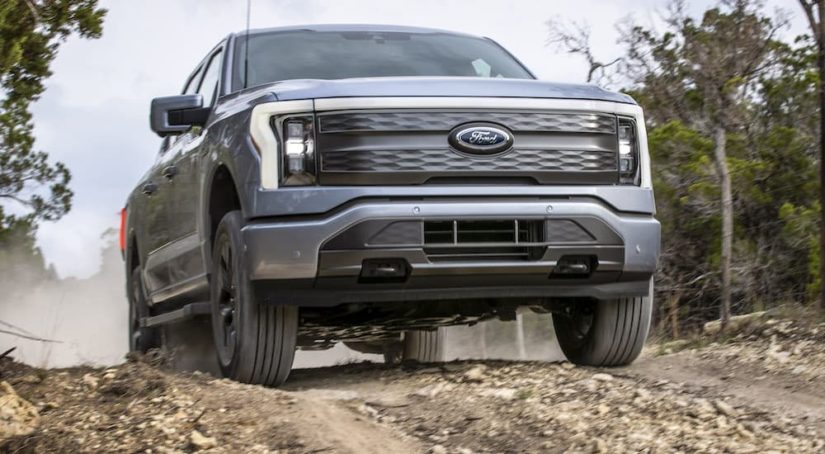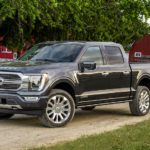The Ford F-series of trucks has had a diverse array of options to choose from ever since the F-1 through F-8 models rolled off the assembly line in the late 1940s. Modern models include the versatile F-150, the off-road-ready F-150 Raptor, and the heavy-duty F-250, F-350, and F-450. For the 2022 model year, a new truck is joining the lineup at your local Ford dealer: the F-150 Lightning. This all-electric pickup is billed as the truck of the future, so how does it measure up against the F-150 of the present?
We’re going to see how the 2022 F-150 Lightning compares to the gas-powered 2022 F-150. From style and comfort features to power and capability, there’s plenty to discuss. So let’s dive in and see what Ford has in mind for the future and whether it’s real progress or just high-tech hype.
Powertrains & Performance
The 2022 F-150 is available with a range of powertrains, including a 3.3-liter V6 that can deliver 290 hp, a 400-hp 5.0-liter V8, a 3.5L turbo V6 that produces 400 hp, and a 3.5L turbo V6 hybrid that can provide 430 hp. Maximum torque ranges from 265 lb-ft to 570 lb-ft, payload capacity ranges from 1,985 lbs to 3,325 lbs, and maximum towing capacity starts at 8,200 lbs with the base engine and can get all the way up to 14,000 lbs with the 3.5-liter turbo V6. All of these powertrains can be paired with either rear or four-wheel drive.
While the F-150 Lightning doesn’t have as many options to choose from, it makes up for it with impressive stats. Every Lightning comes standard with all-wheel drive and is powered by a pair of electric motors. With the standard-range battery, the motors can produce up to 452 hp, which is already more than any of the powertrains on the F-150 can offer. Upgrade to the extended-range battery, and that gets bumped up to an impressive 580 hp. With either battery, you’ll get up to 775 lb-ft of torque.
Equipped with a standard-range battery, the F-150 Lightning can tow up to 7,700 lbs and carry a payload as high as 2,235 lbs. With the extended-range battery, the towing capacity increases to 10,000 lbs, but due to the added weight of the larger battery, the payload capacity drops down to a max of 1,800 lbs. If you’re going to be regularly towing a heavy trailer or loading the bed up with cement blocks, these stats might be a dealbreaker. But drivers who aren’t in danger of hitting the upper limits of those towing and payload figures can enjoy the extra horsepower and torque provided by the electric powertrain without running into a practical downside.

Fuel Economy & Range
The F-150’s range on a full tank of gas varies between different powertrains, but overall the minimum doesn’t go below 400 miles, even with the powerful V8 engine and 4WD. On the high end, gasoline-only powertrains can get up to 520 miles of range. The F-150 Lightning can’t reach those stats yet. The standard-range battery gets you 230 miles of range, and the extended-range battery ups that to 320 miles.
For running errands around town and heading to worksites close to home, that should be plenty, and as the charging infrastructure in the US improves, it will get easier and easier to charge up during pit stops on longer drives. Still, if you rely on your pickup to drive long distances, then it might be worth sticking to the non-Lightning F-150 for now, though battery technology is also improving, so it’s worth checking back in as EVs continue to evolve and improve.
Comparing the fuel economy of gas-powered vehicles and electric vehicles isn’t exactly a one-to-one, but we can still put the two head-to-head using a stat called MPGe, which means “miles per gallon of gasoline-equivalent.” The EPA uses this number to represent the number of miles that a vehicle can go using a quantity of fuel that contains the same amount of energy as a gallon of gasoline. The combined fuel economy ratings for the F-150’s powertrains range from 20 MPG with the 5.0-liter V8 up to 25 MPG with the hybrid powertrain. For context, the average 2022 vehicle gets 27 MPG, according to the EPA, so even the hybrid F-150 is still burning fuel faster than most new vehicles.
The F-150 Lightning, on the other hand, gets 68 MPGe with the standard-range battery and 70 MPGe with the extended-range battery. That means you can save plenty of money on fuel over time, even accounting for a boost in your electric bill.
Interior
Overall, the cabin of the F-150 Lighting is pretty similar to that of the F-150. One pretty noticeable difference is that the F-150 Lightning has a larger infotainment display, making it easier to read at a glance and letting you look at more information at once without sacrificing font size. The F-150 Lightning is also offered with fewer options for the cabin. While the electric truck only comes with a four-door SuperCrew cab, the F-150 is also available with a regular cab, which has two doors, and a SuperCab, which splits the difference with rear half-doors.
Pro Power Onboard
Pro Power Onboard essentially turns your truck into a mobile generator, which can come in handy on all kinds of worksites. There are four different levels of Pro Power Onboard, some of which are only compatible with certain powertrains. A 2.0kW version that comes with up to four outlets is available with some of the F-150’s all-gas engines. On the hybrid F-150, a 2.4kW version of Pro Power Onboard comes standard. Hybrid owners also have the option to upgrade to a more powerful 7.2kW version that comes with up to six outlets.
Of course, with a more capable battery onboard, the F-150 Lighting is able to take the power up to eleven. A 9.6 kW version is available on the Lightning, offering up to eleven outlets spread throughout the vehicle. Some are in the cab, some in the bed, and some in the front trunk (which also has USB ports for charging personal devices). This makes it easy to spread your workstation out and get power wherever you need it, both inside and out.
Lightning Exclusive Features
Pro Power Onboard may be available for gas-powered F-150s, but Ford Intelligent Backup Power is exclusive to the all-electric powertrain. If your home is properly equipped and you get a Ford Charge Station Pro, then power can flow both ways. Usually, you’ll be hooking up your truck in order to charge it, but in the case of a blackout, an F-150 Lightning with an extended-range battery can be used to power your home for up to three days or up to ten if you’re rationing your power. You can see how much power you have left and change the settings using the truck’s touchscreen, or you can manage it all from your smartphone using the FordPass app.
While a pickup’s bed offers plenty of cargo storage, there are benefits to having an enclosed trunk. It shields your cargo from the weather outside and keeps it hidden from view. With the F-150 Lightning, you can get the best of both. Since the space under the hood no longer needs to hold the engine, it has been hollowed out and turned into a front trunk. This fully-sealed compartment has 14.1 cu.ft. of space and can carry up to 400 lbs.

An Excellent Truck No Matter What
Not only does the Lightning have the obvious benefit of saving drivers from pain at the pump, it also brings a lot of unique features to the table. Truck lovers are sure to appreciate its extra horsepower and torque, and everyone from construction workers to campers to tailgate partiers can make use of the built-in outlets and additional cargo space. The Lightning’s limited range and towing and hauling capacities may be deal breakers for some, but there are plenty of drivers who won’t find those stats to be much of a tradeoff at all. Clearly, Ford has put the time and effort in to ensure that this electric F-150 is just as capable and praiseworthy as its predecessors.



